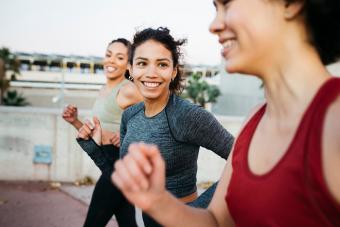
New physical fitness trends are constantly developing. These trends may be the result of sophisticated research, changing attitudes toward the body's physical appearance and development of new fitness products and types of equipment.
Factors That Influence Physical Fitness Trends
Physical fitness trends are interesting, because they can be seen as a reflection of the values of a society. In fact, a trip down Fitness Memory Lane reveals some interesting insights and often humorous information about attitudes and values. Attitudes regarding gender are particularly interesting.
Gender Factors
Most people understand that the idea that weightlifting builds big, unsightly muscles in women is a fallacy. In fact, weight-training and weight-bearing exercises are recommended as prevention against osteoporosis. The gender factor is also important when considering all-male or all-female gyms. Most gyms were segregated until the 1970s. Corporate gyms, such as the New York Athletic Club, were men-only.
As women began to enter the corporate world, they demanded entry into these all-male centers. More gyms became co-ed, but as women were allowed to join elite executive gyms, men began to demand access to all-female gyms. Co-ed gyms inspired the creation of classes that can be enjoyed by men and women. Classes such as step, kickboxing and boot camp focused less on intricate choreography and began to focus more on athletic, sport-oriented movements.
Research Sophistication
Research is another factor that influences physical fitness trends. Research methods are becoming more sophisticated and more available to the general public. As a result, many fitness participants understand that spot reduction is a myth and that well-rounded fitness programs are optimal for overall fitness. Fitness instructor certification requirements are also becoming more stringent, which means that accurate fitness information is easier to dispense.
The Cause-and-Effect Factor of Fitness Trends
Cause-and-effect is an interesting way to explain the changing trends in physical fitness. The high-impact, "work for the burn" routines of the 1970s and 1980s resulted in numerous injuries. Then, in the 1990s, fitness participants suddenly became interested in Pilates, yoga, balance training and activities that prevent and help rehabilitate overuse injuries.
The 1930s to the 1950s: Fitness Femininity
The trends of the 1930s through the 1950s are an excellent example. Women of this period were encouraged to be attractive and feminine, but not muscular. Consider the classic George Cukor movie, The Women. Much of the movie took place at a women's health spa. The exercise coach is described as a drill sergeant and the female characters are more enthusiastic about their manicures than their workouts. Fitness was not regarded as a means of staying healthy or improving self-esteem. It was regarded as a method of looking good, keeping one's husband and competing with other women.
The 50s and 60s: Prudden, LaLanne and The Figure Salon
Bonnie Prudden and Jack LaLanne began their fitness TV show in the late 1950s, allowing men and women to exercise in the privacy of their own homes. These were mostly "floor exercises," which would not build "big, bulky muscles." A new phenomenon emerged in the 1960s. Women's fitness centers, otherwise known as "figure salons", sprang up throughout the country. These centers focused on weight loss and spot reduction. Many of the exercise machines were passive. A rolling machine was designed to roll away fat from the so-called "problem areas." An electronic vibrating belt could be attached to the thighs. Its vibrations supposedly jiggled the fat from the thighs.
The 1970s and 1980s: Jane Fonda and Kenneth Cooper
Jane Fonda and Kenneth Cooper had a profound influence on the fitness trends of the 1970s and 1980s. Leg-warmer clad women, dressed in thong leotards, worked for the burn to the sounds of pulsating music. Meanwhile, the research performed at the Kenneth Cooper Clinic in Dallas proved the importance of aerobic exercise. Physical fitness became a status symbol. A New York magazine article titled The Physical Elite described a class of workout fanatics as an "an emerging super-race." The exercise may have been healthy, but the obsessive nature of some of the participants caused a variety of serious overuse injuries.
The 1990s: A Time to Reflect
The fitness and financial overindulgence of the 80s were paid for in the 90s. This was reflected in the popular fitness trends. Correcting posture and balancing muscle groups became a priority. Financial considerations inspired a "back to basics" approach. Stability balls and resistance bands took the place of high-tech gym equipment.
Meanwhile, an interest in ecology and the environment inspired people to get outdoors. Sport specific workouts were developed to complement outdoor activities. Concern about health insurance and health care cost may be partially responsible for the functional training trend, which encourages exercises that simulate and improve the biomechanical efficiency of every day movements.
The Millennium and the Age of Technology
Mom and Dad may understand the importance of fitness, but junior would rather play with his Nintendo. Enter the Wii Fitness system, a Nintendo game that is actually a workout. The age of technology has also inspired online and web-based fitness programs. You can even have a workout with a cyber personal trainer. Even George Jetson would be surprised.







